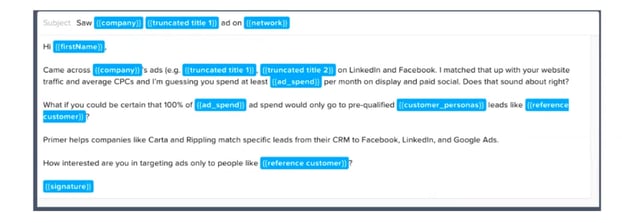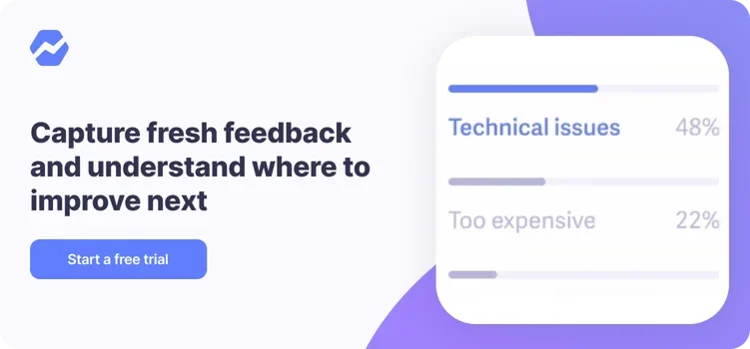Table of Contents

Tip 1: The 3 facets of campaign building
Whether you’re branching out into new target segments, or you have a limited audience pool you’ve already exhausted and are contacting again, there are 3 facets to develop in your campaigning:
- Relevance: reaching the right people at the right time
- Reach: accessing your ICPs on the right platforms
- Message: saying something that resonates
Relevance
Relevance breaks down into two factors: who, and when.
First of all, your campaign needs to target the right audience, i.e. your Ideal Customer Profile, or ICP.
You’ll need to find out who these people are, run data analyses into your prospects, and interview converted ICPs for their patterns that you can use to run projections.
For a step by step guide, here is a detailed handbook on developing your ICPs. And here is a how-to for analyzing user behavior with customer segmentation using Baremetrics.
The second factor, timing, takes into consideration any major inflection points in a prospect’s work-life that could signal a good time to strike.
Conduct research into the public data of leads to find any of the following changes:
- Moved to a new job (track via Linkedin Sales Navigator)
- Achieved recent external funding (monitor on Crunchbase or PitchBook)
- Made significant new hires (visible through job posting platforms)
- Purchased new software (spot signals via BuiltWith or 6sense)
- Changed their brand identity or website (track with Visualping or similar)
- Shifted their product or service offering
- Posted about specific pain points on social media
- Engaged with competitor content or reviews
- Showed intent signals through content consumption patterns
If you’ve reached out to a lead before but they didn’t convert, it’s worth taking another shot if they, or their business, recently underwent some major changes.
That said, first impressions do count, so you’ll want to switch up something significant in your campaign’s relevance, reach, or message, to trigger a different outcome.
Reach
Reach is no longer about just finding contact information—it's about creating multi-touch, omnichannel experiences that meet potential prospects where they naturally engage.
To develop these memorable campaigns, you can utilize strategies like:
- Leveraging intent data platforms like Bombora and 6sense to identify when prospects are actively searching for solutions
- Establishing multiple touchpoints for potential clients across email, Linkedin, targeted ads, and even customized landing pages specific to their pain points
- Tap into community-led growth and engage prospects in Slack communities, different subreddits, and niche forums where they seek peer advice
- Generate interactive content (such as assessment tools, calculators, and interactive demos) with vibe coding tools like Replit to engage your audience
The key is understanding not just where your prospects are, but when and how they prefer to engage with your content.
Message
The third aspect of resonance marketing is your campaign message itself.
In order to be effective, this process requires rigorous testing. As you implement incremental changes, be meticulous about documenting the exact impact of each tweak you make.
Here are some of the elements you should conduct A/B testing on:
- Opening lines (subject lines for email, headlines for ads)
- Body copy and value propositions
- CTAs
- How much custom data to include in outreach
- Visual elements
- Interactive elements like polls or quizzes
The results of these tests, if segmented correctly, should speak for themselves. If by the 10th iteration you’re not seeing notable results, this is an indication that there is something fundamentally wrong with your campaign thesis. It’s time to take a big step back and look at the key assumptions you’re making.
If you need a fresh perspective, here are some alternative marketing strategies to check out.
Your message should be true to your brand identity above all else. The purpose of this testing process is to identify what matters most to your prospects, so you can emphasize those features during outreach.
Tip 2: The importance of research
High impact campaigns are founded on quality of research, leveraged expertly.
Mined data serves the following purposes:
- To qualify or disqualify accounts to target, based on whether they fit your ICP
- To personalize ad copy and messaging patterns
Data sets, on the whole, are extremely overexploited. The more easily data can be accessed, even for a fee, the more people will already have leveraged it.
The better your detective work, the more valuable the data you retrieve will be. Make sure you’re doing this primarily for high value ICPs though, so you’re seeing good returns.
Where to look
There’s a plethora of tools out there to help you locate the data you need on your ICPs. Different platforms specialize in different types of data sets. Here is a useful guide on using sales data tools for SaaS businesses.
Fundraising data:
- Crunchbase Pro
- Apollo
- PitchBook
- Harmonic.ai
Technographic data (what tools a company is using):
- BuiltWith
- 6sense
- HG Insights
- Clearbit (now part of HubSpot)
Job change data:
- LinkedIn’s Sales Navigator
- Apollo.io
- Cognism
Review page data:
- G2
- Gartner Peer Insights
- TrustRadius
For startups with limited budgets, consider starting with tools like Apollo.io or Clay, which consolidate multiple data sources into unified platforms. These tools offer excellent ROI for early-stage companies looking to build sophisticated outreach campaigns without breaking the bank.
How to interpret data
The best way to interpret the data you’ve uncovered is segment by segment. Here’s a guide on how to do that using Baremetrics’ large scope of metrics. Try it out for yourself using the free 14 day trial here.
Some of your best data sets on prospects are already in your lap – simply look into the features and behaviors of your current customer base. Many of these qualities will be replicated among your leads.
This data is so valuable for two reasons: you have the opportunity to interview your clients directly, and you’re the only one with access to that exact data set.
How to leverage data sets effectively
The fuller the picture you have on your targets, the more you can adapt your approach. This gives your messaging the best chance to truly resonate with its audience.
The most effective high touch campaigns stitch together all available information to create an approach that, to the prospect, feels like it was custom-made only for them.
Here’s an example of a customized email automation that plugs in all this data:

As you can see, this cold email pulls information about the prospect’s company size, ad spend, and top customers, to create a highly customized approach. Sprinkle in some common pain points and bold promises – that’s powerful!
Recap
Research is an invaluable investment into your business growth.
Resonance marketing requires your outreach to be relevant to prospects in timing and intent, have an effective reach, and wield a strong message.
And at the core of any powerful, 3-dimensional campaign, lives data.
The foundation of successful resonance marketing remains rooted in deep research that reveals not just who your prospects are, but when they're experiencing inflection points that signal readiness to buy. By tracking job changes, funding rounds, new hires, and technology adoptions (now with the help of AI), you can ensure your relevance hits at exactly the right moment.
Your reach must extend beyond single channels to meet prospects where they naturally engage—whether that's through intent data platforms, multi-channel content strategies, or community-led growth in the spaces where your ICPs seek peer advice.
The most successful organizations will be those that combine meticulous research with authentic connection, leveraging data and AI tools not as a crutch but as a compass that guides them toward genuine value alignment with their customers.







